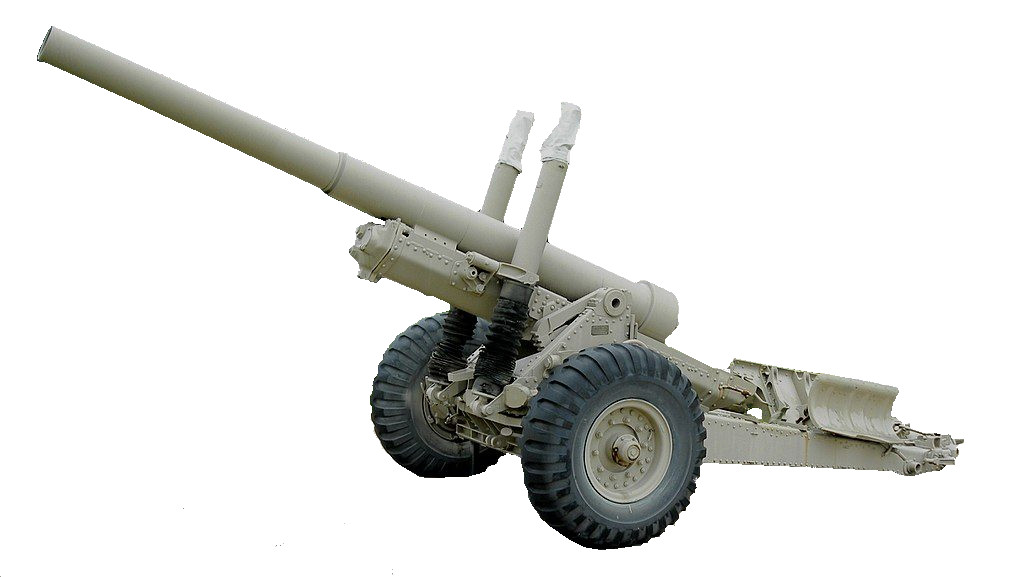
In the early 1930’s discussions began on replacing the old 6 inch gun & 6 inch 26 cwt howitzer. An Operational Requirement was issued in January 1939 & it was discovered that the best calibre to meet the requirements was a 5.5 inch Medium gun.
There were many problems during the development and parts had to be re-designed & replaced. Because of this and problems organising production, the first 5.5 inch Medium Gun didn’t go into action in the Western Desert until May 1942. There were some objections to its lack of range but this was solved in 1943 when the standard HE shell was changed from 100 lbs to 80 lbs.
The service weapon was the Mark 3 gun. Marks 1 & 2 had been WW1 Navy weapons which bore no relationship to the army gun. Post war the Mark 4 was introduced with just a change to the taper in the chamber. The 5.5 inch Medium Gun remained in British service until 1980 although it continued in service with other nations for much longer.
Gun
| Mk 3 | Auto-frettaged loose barrel in a short jacket. Asbury interrupted Welin screw breech, percussion fired. |
| Mk 4 | Alteration to the angle of shot seating in the chamber. Introduced in 1948. |
Carriage
| Marks 1 & 2 (only differences are a change from rivetted to welded construction) | Split trail with hydropneumatic recoil system. Hydropneumatic balancing cylinders in 2 vertical mounts to balance the barrel mass. Because of leakage problems these were changed to springs. Trough cradle with trunnions towards the rear to allow recoil at full elevation. Quick loading gear. |
Crew
| No.1 | Detachment Commander |
| No.2 | Breech Operator – fires gun |
| No.3 | Layer |
| No.4 | Load & Ram |
| No.5 | Load & Ram |
| No.6 | Prepare cartridges |
| No.7 | Prepare shells |
| No.8 | Prepare shells |
| No.9 | Prepare shells |
| No.10 | Coverer, supervise ammunition |
Data
| Weight of gun & breech mechanism | 4,120 lbs |
| Total length | 171.6 inches |
| Length of bore | 164 inches (30 calibres) |
| Rifling | 36 grooves, uniform right hand 1/25 |
| Breech mechanism | Asbury interrupted screw, percussion fired |
| Elevation | – 5° to +45° |
| Traverse | 30° left & right |
| Recoil system | Hydropneumatic, variable, 30 inches to 54 inches |
| Weight in action | 13,646 lbs |
Performance
| Firing 100 lb HE shell | |
| Muzzle Velocity | 1,675 feet/second |
| Maximum Range | 16,200 yards |
| Firing 80lb HE shell | |
| Muzzle Velocity | 1,950 feet/second |
| Maximum Range | 18,100 yards |
Ammunition
Separate loading, bag charge
| Shell, HE, S/L, 100lb Mk 1D | Streamlined shell with single, wide, driving band. Could be fitted with Fuze, Precussion, 119 or 231 |
| Shell, HE, S/L, 100lb Mk 2D | Same as Mk 1D except had double driving bands for better sealing in the bore. |
| Shell, HE, S/L, 80lb Mk 1D | Almost the same size as the 100lb shell. Double driving bands & painted black from the bands to the rear. This indicated it was an 80lb shell. |
| Shell, Smoke, BE, Mk 1D | Rarely issued, it used a Time & Percussion Fuze No. 221 |
| Shell, Coloured Smoke, BE, Mk 1D | Not produced until September 1945. Unlikely to ever had been issued to service regiments. |
| Propelling Charge | Originally a four charge system. Charge 1 for short range with Charge 2 as an increment. Charge 3 for long range with Charge 4 as an increment. A Super Charge was introduced with the 80lb shell. It was never fired with the other charges. |
